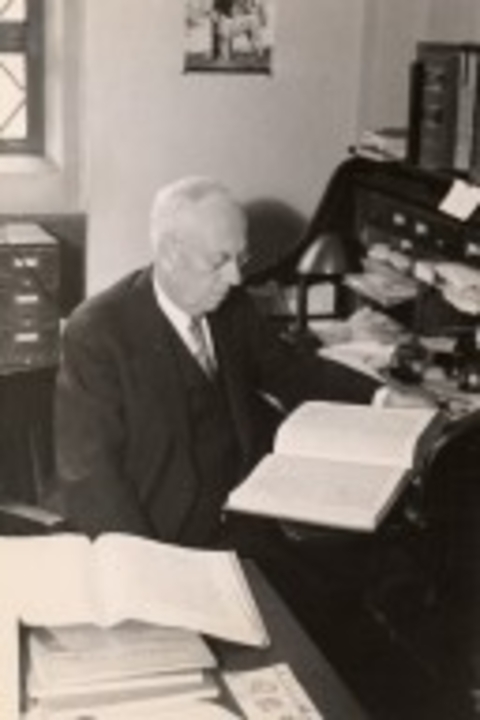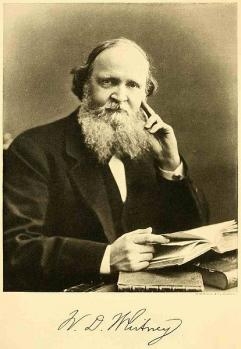
William Dwight Whitney
William Dwight Whitney was born in 1827 in Northampton, MA. He entered Williams College at the age of 15, graduated in 1845 as an 18 year old, and then attended the newly established Graduate School at Yale to study Sanskrit.
In 1850, Whitney went to Berlin to study Indo-European philology with Weber and Bopp; then to Tübingen to study under Roth. On returning to the United States, Whitney replaced Salisbury as professor of Sanskrit at Yale, where he also taught modern languages, and later became professor of Comparative Philology (1869). His students at Yale included Charles R. Lanman.
Whitney served as secretary to the American Oriental Society from 1857 and became president of the society in 1884. He assisted in the editing of the 1864 edition of Webster’s American Dictionary, and in 1869 helped found the American Philological Association, also serving as its first president.
Whitney’s many important publications include Language and the Study of Language (1867), A Sanskrit Grammar (1879), and The Roots, Verb-forms and Primary Derivatives of the Sanskrit Language (1885).
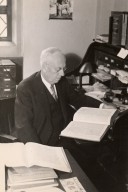
Edgar H. Sturtevant
Edgar H. Sturtevant was born in Jacksonville, Illinois, the older brother of Alfred Sturtevant. He studied at the University of Chicago receiving there in 1901 a Ph.D. with a dissertation on Latin case forms. He became an assistant professor of classical philology at Columbia University in New York before joining the linguistics faculty at Yale University in 1923. In 1924, he was a member of the organizing committee for the founding, with Leonard Bloomfield and George M. Bolling, of the Linguistic Society of America (LSA).
Besides research on Native American languages and field work on the Modern American English dialects, he is the father of the Indo-Hittite hypothesis, first formulated in 1926, based on his seminal work establishing the Indo-European character of Hittite (and the related Anatolian languages), with Hittite exhibiting more archaic traits than the normally reconstructed forms for Proto-Indo-European.
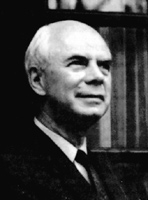
Murray Barnson Emeneau
Murray Barnson Emeneau (February 28, 1904 – August 29, 2005) was an emeritus professor and founder of the Department of Linguistics at the University of California, Berkeley.
Emeneau was born in Lunenburg, a fishing town on the east coast of Nova Scotia, Canada. Having distinguished himself in classical languages in high school, he obtained a four-year scholarship to Dalhousie University in Halifax to further his classical studies. On obtaining his B.A. degree from Dalhousie, Emeneau was awarded a Rhodes Scholarship to Balliol College at Oxford University. From Oxford he arrived at Yale University in 1926, where he took a teaching appointment in Latin. While at Yale, Emeneau began Sanskrit and Indo-European studies with the Sanskritist Franklin Edgerton and Indo-Europeanist Edgar Sturtevant. In 1931 Emeneau was awarded his Ph.D. with a dissertation on the Vetālapañcaviṃśatī.
Given the dire employment situation in the early 1930s, Emeneau stayed on at Yale after completing his dissertation, taking courses in the “new linguistics” being taught by Edward Sapir. Emeneau wrote:
I was exposed to methods of fieldwork on non-literary languages, including intensive phonetic practice and analysis of material, but especially to Sapir’s approach to anthropological linguistics, in which language is only part of the total culture, but a most important part, since in it the community expresses in its own way, ‘verbifies’ its culture.
—1980, 352
It was Sapir who suggested that Emeneau take up a study of the Toda language of the Nilgiri hills in South India with an aim toward a comparative study of the Dravidian Languages. Emeneau may have been the last student of Sapir.
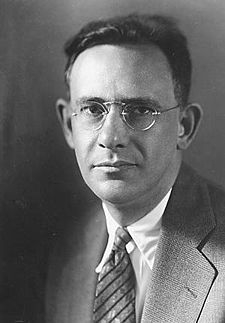
Edward Sapir
Born in Germany, Edward Sapir was brought to the United States in 1889 at the age of five. As a student at Columbia, where he worked with Franz Boas, he received a Masters in Germanics and a PhD (1909) on the Takelma language, spoken in Oregon. While working at Berkeley and UPenn, Sapir did fieldwork on Takelma, Chinook, Yana, Southern Paiute and Ute.
From 1910, as an anthropologist at the Canadian National Museum in Ottawa, Sapir conducted fieldwork on a large number of languages including Nootka and Sarcee, an Athabaskan language.
In 1925 Sapir moved to the University of Chicago, where he continued to do fieldwork on languages including Navajo and Hupa, before accepting the offer of a Sterling Professorship at Yale in 1931. He attracted a number of students at Yale, including Stanley Newman, Morris Swadesh, Mary Haas and Benjamin Whorf.
Sapir was a colleague of Bloomfield at Chicago, and corresponded extensively with Trubetzkoy in the 1930s. When the International Phonological Association was established in Prague in 1932, Sapir was elected as the sole American member of its board. He continued to be the primary link between European and American phonologists until his death in 1939.
[adapted from S.R. Anderson, Phonology in the Twentieth Century, pp. 217-221].

Benjamin Lee Whorf
Benjamin Lee Whorf (April 24, 1897 in Winthrop, Massachusetts – July 26, 1941) was an American linguist. Whorf is widely known for his ideas about linguistic relativity, the hypothesis that language influences thought. An important theme in many of his publications, he has been credited as one of the fathers of this approach, often referred to as the “Sapir–Whorf hypothesis”, named after him and his mentor Edward Sapir. Originally educated as a chemical engineer, he took up an interest in linguistics late in his life, studying with Sapir at Yale University. In the last ten years of his life he dedicated his spare time to linguistic studies, doing field work on Native American languages in the United States and Mexico. He managed to become one of the most influential linguists of his time, even while still working as a fire inspector for the Hartford Fire Insurance Company. He published a grammar of the Hopi language, studies of Nahuatl dialects, Maya hieroglyphic writing, and the first attempt at a reconstruction of Uto-Aztecan. He also published many articles in the most prestigious linguistic journals, many of them dealing with the ways in which he saw that different linguistic systems affected the thought systems and habitual behaviour of language users.
Whorf’s publications include The Comparative Linguistics of Uto-Aztecan (1935), Maya Writing and Its Decipherment (1935), Discussion of Hopi Linguistics (1937), Science and Linguistics (1940), Linguistics as an Exact Science (1940), Languages and Logic (1941), Grammatical Categories (1945), An American Indian Model of the Universe (1950), and A Review of General-Semantics (1950)
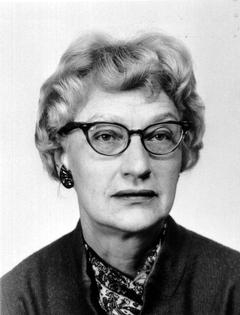
Mary Rosamund Haas
Mary Rosamund Haas (January 12, 1910, Richmond, Indiana - d. May 17, 1996) was an American linguist who specialized in North American Indian languages, Thai, and historical linguistics.
At the University of Chicago she undertook graduate work on comparative philology. It was at Chicago that Haas began to study under Edward Sapir, whom she would follow to Yale. She began a long career in linguistic fieldwork at that time, studying various languages during the summer months. The languages that she studied over the ten-year period from 1931 to 1941 included Nitinat, Tunica, Natchez, Creek, Koasati, Choctaw, Alabama, and Hichiti. Her first published paper, A Visit to the Other World, a Nitinat Text, a collaboration with Morris Swadesh (to whom she would later be married for a time), was published in 1933.
She went on to complete her Ph.D. in linguistics from Yale University in 1935 with a dissertation entitled A Grammar of the Tunica Language. (Tunica was a language once spoken in what is now Louisiana.) Haas worked with the last fluent speaker of Tunica, Sesostrie Youchigant, producing extensive texts and vocabularies. She received the Ph.D at the age of 25.
Shortly afterwards, she conducted fieldwork with the last two speakers of the Natchez language in Oklahoma, Watt Sam and Nancy Raven, resulting in extensive unpublished field notes that constitute the most reliable source of information on the language. Shortly after this, she conducted extensive fieldwork on the Creek language as well, and was the first modern linguist to collect extensive texts in the language. Most of her notes on Creek and Natchez remain unpublished, though they have begun to be used by contemporary linguists.
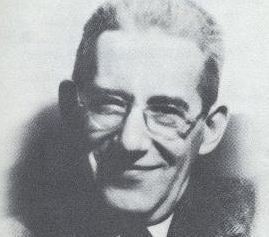
Leonard Bloomfield
Leonard Bloomfield (April 1, 1887 – April 18, 1949) was an American linguist who led the development of structural linguistics in the United States during the 1930s and the 1940s. His influential textbook Language, published in 1933, presented a comprehensive description of American structural linguistics. He made significant contributions to Indo-European historical linguistics, the description of Austronesian languages, and description of languages of the Algonquian family.
Bloomfield’s approach to linguistics was characterized by its emphasis on the scientific basis of linguistics, adherence to behaviorism especially in his later work, and emphasis on formal procedures for the analysis of linguistic data. The influence of Bloomfieldian structural linguistics declined in the late 1950s and 1960s as the theory of Generative Grammar developed by Noam Chomsky came to predominate.
Bloomfield was Instructor in German at the University of Cincinnati, 1909-1910; Instructor in German at the University of Illinois at Urbana-Champaign, 1910-1913; Assistant Professor of Comparative Philology and German, also University of Illinois, 1913-1921; Professor of German and Linguistics at the Ohio State University, 1921-1927; Professor of Germanic Philology at the University of Chicago, 1927-1940; Sterling Professor of Linguistics at Yale University, 1940-1949. During the summer of 1925 Bloomfield worked as Assistant Ethnologist with the Geological Survey of Canada in the Canadian Department of Mines, undertaking linguistic field work on Plains Cree; this position was arranged by Edward Sapir, who was then Chief of the Division of Anthropology, Victoria Museum, Geological Survey of Canada, Canadian Department of Mines.
Bloomfield was one of the founding members of the Linguistic Society of America. In 1924, along with George M. Bolling (Ohio State University) and Edgar Sturtevant (Yale University) he formed a committee to organize the creation of the Society, and drafted the call for the Society’s foundation. He contributed the lead article to the inaugural issue of the Society’s journal Language, and was President of the Society in 1935. He taught in the Society’s summer Linguistic Institute in 1938-1941, with the 1938-1940 Institutes being held in Ann Arbor, Michigan, and the 1941 Institute in Chapel Hill, North Carolina.
Bloomfield’s earliest work was in historical Germanic studies, beginning with his dissertation, and continuing with a number of papers on Indo-European and Germanic phonology and morphology. His post-doctoral studies in Germany further strengthened his expertise in the Neogrammarian tradition, which still dominated Indo-European historical studies. Bloomfield throughout his career, but particularly during his early career, emphasized the Neogrammarian principle of regular sound change as a foundational concept in historical linguistics.
Bloomfield’s work in Indo-European beyond his dissertation was limited to an article on palatal consonants in Sanskrit and one article on the Sanskrit grammatical tradition associated with Pāṇini, in addition to a number of book reviews. Bloomfield made extensive use of Indo-European materials to explain historical and comparative principles in both of his textbooks, An introduction to language (1914), and his seminal Language (1933). In his textbooks he selected Indo-European examples that supported the key Neogrammarian hypothesis of the regularity of sound change, and emphasized a sequence of steps essential to success in comparative work: (a) appropriate data in the form of texts which must be studied intensively and analyzed; (b) application of the comparative method; (c) reconstruction of proto-forms. He further emphasized the importance of dialect studies where appropriate, and noted the significance of sociological factors such as prestige, and the impact of meaning. In addition to regular linguistic change, Bloomfield also allowed for borrowing and analogy.
It is argued that Bloomfield’s Indo-European work had two broad implications: “He stated clearly the theoretical bases for Indo-European linguistics…”; and “…he established the study of Indo-European languages firmly within general linguistics….”

Bernard Bloch
Bernard Bloch was born in 1907 in New York City, schooled in Munich and St Louis, and studied English and Classics at the University of Kansas before continuing his language studies at Northwestern.
Bloch served as President of the Linguistic Society of America, in 1953 and editor of the journal Language, after 1939.
Bloch taught Japanese at Brown University and in 1943 became Professor of Linguistics at Yale. He died in 1965 in New Haven.
Some of the many publications of Bloch include The American vowel in bird (1934: in Le Maître Phonétique), A Linguistic Atlas of New England (ed. 1939), Tables for a system of phonetic description (1941), The Japanese language (1942), A set of postulates for phonemic analysis (1948: in Language)
[ Source: Martin Joos’ Obituary, Language 43:3-19 (1967) ]
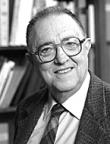
Isidore Dyen
Isidore Dyen (1913 - 2008)
Professor Emeritus of Linguistics,
Saybrook Fellow
press statements and posts
In Memoriam: Isidore Dyen, Was a Specialist in Austronesian Languages. Yale Bulletin. January 16, 2009.
Obituary of Isidore Dyen. Language Log. January 7, 2009.
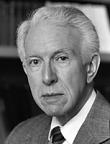
Rulon S. Wells III
Rulon S. Wells III (d. 2008)
Professor Emeritus of Linguistics and Philosophy
press statement
In Memoriam: Rulon S. Wells III, Renowned Linguist and Philosopher. Yale Bulletin. July 18, 2008.
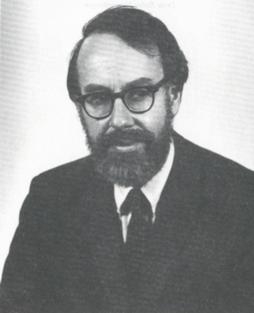
Warren Cowgill
Warren Cowgill (1929-1985; pronounced /koüg¡l/) was a professor of linguistics at Yale University and the Encyclopedia Britannica’s authority on Indo-European linguistics. He was unusual among Indo-European linguists of his time in believing that Indo-European should be classified as a branch of Indo-Hittite, with Hittite as a sister language of the Indo-European languages, rather than a daughter language. He was also a supporter of the Indo-Uralic hypothesis.
Warren Cowgill and his twin brother, anthropologist George Cowgill, were born near Grangeville, Idaho. He graduated from Stanford University in 1952 and received a Ph.D. from Yale in 1957. He was a member of the Yale faculty in the Department of Linguistics until his death in 1985.
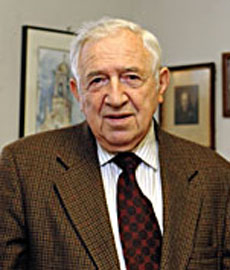
Edward Stankiewicz
Edward Stankiewicz was born on Nov. 17, 1920 in Warsaw, Poland.
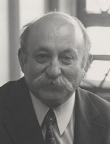
Sebastian Shaumyan
Sebastian Shaumyan (1916 - 2007)
Professor Emeritus of Linguistics
Research Interests
Semiotics, Applicative Universal Grammar.
Selected Publications
Shaumyan 2006. Signs, Mind, and Reality: A Theory of Language as the Folk Model of the World. Philadelphia: John Benjamins Publishing Company.
Shaumyan 1987. A Semiotic Theory of Language. Indiana University Press.
Shaumyan 1977. Applicational grammar as a semantic theory of natural language. Edinburgh: Edinburgh University Pres

Harold Conklin
Harold Colyer Conklin (April 27, 1926 – February 18, 2016) was an American anthropologist who conducted extensive ethnoecological and linguistic field research in Southeast Asia (particularly the Philippines) and was a pioneer of ethnoscience, documenting indigenous ways of understanding and knowing the world.
Conklin was born in Easton, Pennsylvania in 1926 but moved before the age of one to his father’s hometown of Patchogue, New York. Interested in Native American culture from an early age, he was adopted by the St. Regis Mohawk tribe of the Akwesasne (Mohawk) Nation in 1939, when he was in eighth grade. While in high school, he pursued his interest in anthropology by serving as a volunteer at the American Museum of Natural History under anthropology curator Clark Wissler.
Conklin entered the University of California, Berkeley as an undergraduate in 1943, studying with anthropologists Robert Lowie, Alfred L. Kroeber, and Edward W. Gifford, as well as geographer Carl O. Sauer. He attended Berkeley for one year before being inducted into the United States Army in July 1944. After serving briefly in New Guinea and Leyte, he served with the 158th Infantry Regiment on the island of Luzon in the Philippines.
When World War II came to an end, Conklin continued serving with the Army in the Philippines until his discharge in August 1946. With the support of the Berkeley anthropology department he remained in the Philippines to conduct fieldwork for a year and a half. In 1947, he traveled to Mindoro and Palawan for a linguistic and cultural survey, spending time with the Hanunóo, an upland tribe in Mindoro. In Manila, he met with the tropical botanist Harley Harris Bartlett, who instructed him in botanical research and provided him with funds to create an ethnobotanical collection from Palawan.
Conklin returned to Berkeley in 1948 and finished his undergraduate work in 1950. He then started graduate school in anthropology at Yale University. At Yale he studied with Floyd Lounsbury (who became his dissertation advisor), Bernard Bloch, and Isidore Dyen, among others. His fellow graduate students included William C. Sturtevant and Charles Frake, who shared his interest in language, culture, and cognition. He conducted fieldwork among the Hanunóo in Mindoro from 1952 to 1954, completing his dissertation in 1955.

Stanley Insler
Stanley Insler (1937-2019) died on January 4, 2019. He was Professor Emeritus of Linguistics at Yale University, the Edward E. Salisbury Professor of Sanskrit and Comparative Philology in the Department of Classics.
- Tributes to Stanley Insler from the American Oriental Society
- Language Log blog post on Stanley Insler
- New Haven Register obituary
Insler Citation (on the occasion of his retirement)
Edward Sturtevant
Edgar H. Sturtevant(opens in a new window/tab) was born in Jacksonville, Illinois, the older brother of Alfred Sturtevant. He studied at the University of Chicago receiving there in 1901 a Ph.D. with a dissertation on Latin case forms. He became an assistant professor of classical philology at Columbia University in New York before joining the linguistics faculty at Yale University in 1923.
